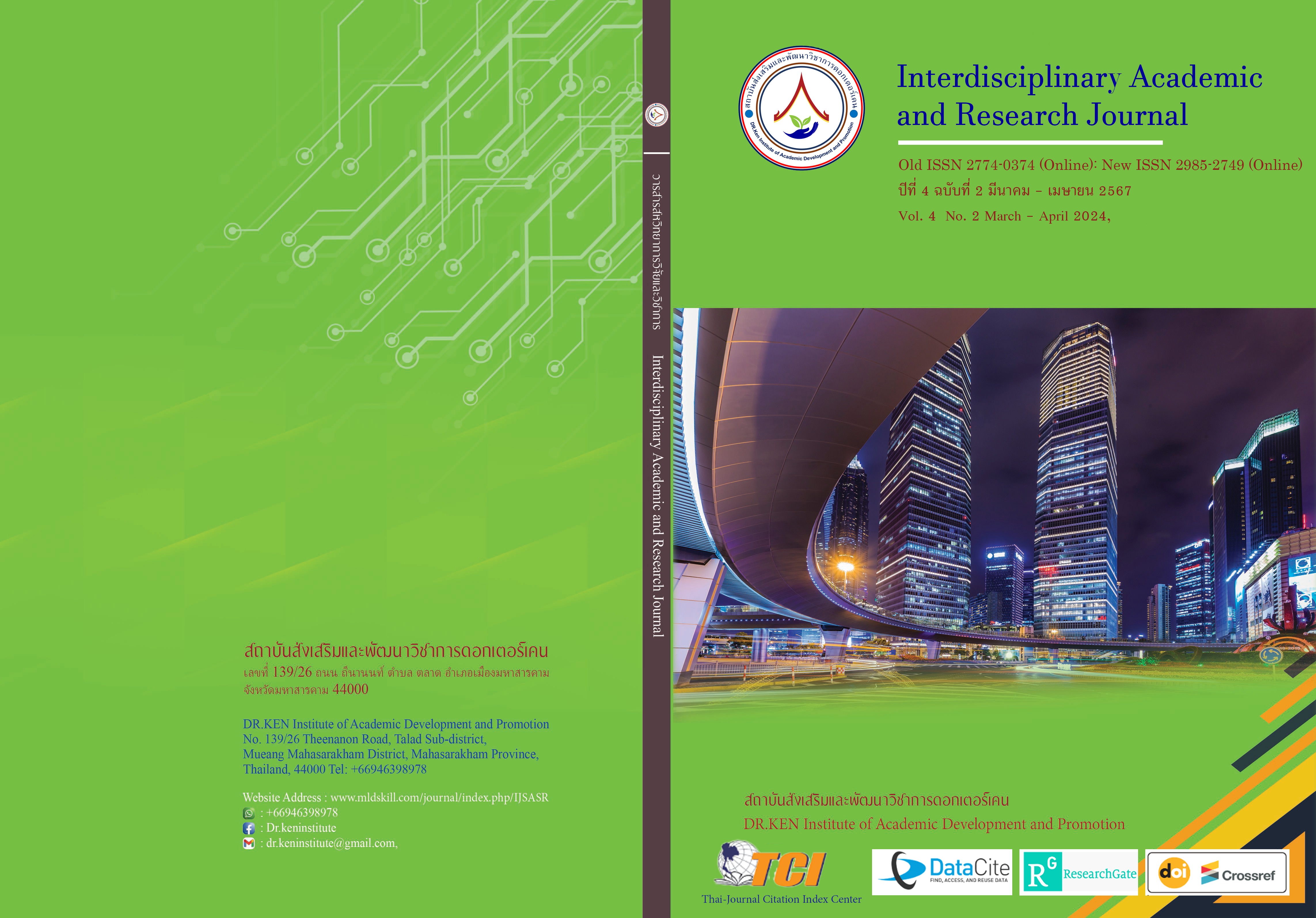Guidelines for Developing Schools into Educational Innovation Organizations Under the Office of Mahasarakham Primary Educational Service Area Office 2
DOI:
https://doi.org/10.60027/iarj.2024.274642Keywords:
Guidelines for Developing; , Educational Innovation Organizations; , The New Management of Small SchoolsAbstract
Background and Aims: The development of educational institutions into innovation organizations is of utmost importance for ensuring high-quality education management. In this era of educational innovation, the new responsibilities of educational administrators require an augmented focus on innovation management to align with the advancements in the education sector. Therefore, this research aims to (1) study the current desirable state and the priority need of developing schools into educational innovation organizations under the office of Mahasarakham primary educational service area office. (2) Study the guidelines for developing schools into educational innovation organizations under the office of Mahasarakham primary educational service area office 2.
Methodology: The research procedures were divided into two phases. The first stage was to study the current desirable state and the priority need of developing schools into educational innovation organizations, The sample group consisted of 306 school administrators and teachers, by stratified random sampling. The research instrument was a five-level questionnaire, with a reliability of 0.94. The statistics used for data were analyzed by mean, and standard deviation. The second stage was the study of the guidelines for developing schools into educational innovation organizations. The target groups include 3 schools for visiting best practices for studying the development guidelines and 9 experts for evaluating guidelines. The research instruments were interview form and evaluation form the suitability and feasibility.
Results: The current state of developing schools into educational innovation organizations under the office of Mahasarakham Primary Educational Service Area office 2 overall was moderate level average and the desirable state overall was at the highest level. The priority needs ranked from high to low level were cooperation, 1) organizational culture 2) personnel development 3) innovative climate 4) organizational structure 5) strategic management. The guidelines for developing schools into educational innovation organizations, Include 1) principal 2) objectives 3) content 4) development 5) measurement and evaluation, Development content includes 5 modules: 1) organizational culture 2) personnel development 3)innovative climate 4) organizational structure 5) strategic management. The overall assess suitability and feasibility of the guidelines were at the highest level.
Conclusion: The development of educational management into an innovation organization is crucial for the quality of school management and educational administration. This is because an innovation organization focuses on fostering innovation within the organization through proactive management, introducing new practices, and continuously developing and improving existing methodologies. Key components of this approach include organizational culture, personnel development, innovative climate, organizational structure, and strategic management.
References
จักรกฤษณ์ สิริริน. (2561). Innovation Management ติดปีกสถานศึกษาสู่ยุค 5.0. Retrieved from: https://www.salika.co/2019/09/05/innovationmanagement-educational-5-0-era/
นวชล สมบูรณ์สิน. (2564). รูปแบบการจัดการนวัตกรรมทางการบริหารในสถานศึกษาขั้นพื้นฐาน. วิทยานิพนธ์ดุษฎีบัณฑิต: มหาวิทยาลัยนเรศวร.
นันท์มนัส รอดทัศนา. (2554). การจัดทำคู่มือจัดกิจกรรมพัฒนาความมีวินัยของนักเรียนชั้นประถมศึกษาปีที่ 6 โรงเรียนสารสาสน์วิเทศบางบอน. วิทยานิพนธ์การศึกษามหาบัณฑิต : มหาวิทยาลัยศรีนครินทรวิโรฒ.
ประสิทธิ์ อุ่นหนองกุง. (2559). รูปแบบการพัฒนาภาวะผู้นำทางวิชาการของผู้บริหารโรงเรียนพระปริยัติธรรม แผนกสามัญศึกษา ภาคตะวันออกเฉียงเหนือ. วิทยานิพนธ์ครุศาสตรดุษฎีบัณฑิต: มหาวิทยาลัยราชภัฏสกลนคร.
พสุ เดชะรินทร์. (2554). การวางแผนเชิงยุทธศาสตร์. กรุงเทพฯ: สำนักงาน ก.พ.ร.
พัชรพร สันติวิจิตรกุล. (2553). การพัฒนาคู่มือวิจัยในชั้นเรียนสำหรับครูผู้สอนในโรงเรียนองค์การบริหารส่วนจังหวัดสุราษฎร์ 1 (ดอนสักผดุงวิทย์). วิทยานิพนธ์ครุศาสตรมหาบัณฑิต (การบริหารการศึกษา): มหาวิทยาลัยราชภัฏสุราษฎร์ธานี.
ภารดี อนันต์นาวี. (2564). องค์กรนวัตกรรมทางการศึกษา: การบริหารจัดการ. วารสารวิชาการ มหาวิทยาลัยนอร์ทกรุงเทพ. 10 (2), 10-21.
รัตนวดี โมรากุล. (2560). การวิเคราะห์องค์ประกอบองค์การแห่งนวัตกรรมของสถานศึกษาขั้นพื้นฐาน. นครปฐม: มหาวิทยาลัยราชภัฏนครปฐม.
เรืองชัย จรุงศิรวัฒน์. (2554). เทคนิคการเขียนคู่มือปฏิบัติงาน. ขอนแก่น : สำนักงานอธิการบดี มหาวิทยาลัยขอนแก่น.
วุฒิพงษ์ ภักดีเหลา. (2554). การศึกษาคุณลักษณะขององค์การนวัตกรรม:กรณีศึกษาองค์การที่ได้รับรางวัลด้านนวัตกรรม. วิทยานิพนธ์วิทยาศาสตรมหาบัณฑิต (การพัฒนาทรัพยากรมนุษย์และองค์การ): สถาบันบัณฑิตพัฒนบริหารศาสตร์.
สมบัติ นามบุรี. (2562). นวัตกรรมและการบริหารจัดการ. วารสารวิจัยวิชาการ, 2(2), 121-134.
สำนักงานเขตพื้นที่การศึกษาประถมศึกษามหาสารคาม เขต 2. (2566). รายงานผลการปฏิบัติราชการประจำปีงบประมาณ 2566. กลุ่มนโยบายและแผน สำนักงานเขตพื้นที่การศึกษาประถมศึกษามหาสารคาม เขต 2.
สำนักงานคณะกรรมการการศึกษาขั้นพื้นฐาน. (2561). คู่มือประกอบการอบรมการขับเคลื่อนกระบวนการ PLC (Professional Learning Community) ชุมชนการเรียนรู้ทางวิชาชีพสู่สถานศึกษา. กรุงเทพฯ : จามจุรีโปรดักส์.
สำนักงานคณะกรรมการพัฒนาการเศรษฐกิจและสังคมแห่งชาติ. (2563). แผนปฏิรูปประเทศ. พิมพ์ครั้งที่ 3. กรุงเทพฯ: สำนักงานเลขานุการของคณะกรรมการยุทธศาสตร์ชาติ
สำนักงานคณะกรรมการพัฒนาระบบราชการ. (2562). คู่มือการปฏิบัติงาน เรื่อง การปฏิบัติงานการประเมินส่วนราชการตามมาตรการปรับปรุงประสิทธิภาพในการปฏิบัติราชการของจังหวัด ประจำปีงบประมาณ พ.ศ. 2562. กรุงเทพฯ: สำนักงานคณะกรรมการพัฒนาระบบราชการ
สุธรรม ธรรมทัศนานนท์. (2566). การจัดการสู่องค์การแห่งนวัตกรรมการศึกษา. วารสารสันติศึกษาปริทรรศน์ มจร. 11 (4), 1658-1667.
สุริศา ริมคีรี. (2562). การพัฒนาตัวบ่งชี้องค์การแห่งนวัตกรรมการศึกษาของโรงเรียนมัธยมศึกษาสังกัดสำนักงานคณะกรรมการการศึกษาขั้นฐาน. วิทยานิพนธ์ปรัชญาดุษฎีบัณฑิต (การบริหารการศึกษา คณะศึกษาศาสตร์) : มหาวิทยาลัยบูรพา.
สุวิมล ว่องวาณิช. (2558). การวิจัยประเมินความต้องการจำเป็น. กรุงเทพฯ: สานักพิมพ์แห่งจุฬาลงกรณ์มหาวิทยาลัย.
องค์อร ประจันเขตต์. (2557). องค์กรแห่งนวัตกรรมการศึกษา ทางเลือกใหม่ของการบริหารการศึกษา. วารสารพยาบาลทหารบก, 15 (1), 45-51.
Cronbach, L.J. (1970). Essentials of Psychological Testing. 3rd edition. New York: Harper. And Row.
Holder, B.J., & Matter, G. (2008). The Innovative Organization. Retrieved December from http://www.geocities.com/CollegePark/Library/1048/innova.html.
Krejcie, R.V., & Morgan, D.W. (1970). Determining Sample Size for Research Activities. Educational and Psychological Measurement, 30(3), 607-610.
Tidd, J., Bessant, J., & Pavitt, K. (2001). Managing Innovation Integrating Technological Market and Organization Change. Chichester: John Willey & Sons.
UNESCO. (2005). Guidelines for Inclusion: Ensuring Access to Education for All France. UNESCO.
Von Stamm, B. (2008). Managing Innovation, Design and Creativity. Chichester: John Wiley & Sons.
White, M.A., & Bruton, G.D. (2007). The Management of Technology and Innovation: A Strategic Approach. Toronto: Thomson South-Western.
Downloads
Published
How to Cite
Issue
Section
License
Copyright (c) 2024 Interdisciplinary Academic and Research Journal

This work is licensed under a Creative Commons Attribution-NonCommercial-NoDerivatives 4.0 International License.
Copyright on any article in the Interdisciplinary Academic and Research Journal is retained by the author(s) under the under the Creative Commons Attribution-NonCommercial-NoDerivatives 4.0 International License. Permission to use text, content, images, etc. of publication. Any user to read, download, copy, distribute, print, search, or link to the full texts of articles, crawl them for indexing, pass them as data to software, or use them for any other lawful purpose. But do not use it for commercial use or with the intent to benefit any business.
















.png)


